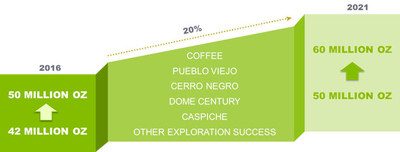VANCOUVER, July 26, 2017 GOLDCORP INC. (TSX: G, NYSE: GG) ("Goldcorp" or the "Company") is pleased to provide an update on its 2017 exploration program. Representative drill results are provided below; website links to further information including full drill results, drill coordinates, QA/QC information and relevant diagrams are provided at the end of each section.
Highlights
- Drilling at Cerro Negro continues to return positive results; exploration budget increased. 2017 budget increased by $6 million to $26 million to accelerate testing of early stage targets with drilling planned at Silica Cap, Eureka SE, San Marcos West, San Marcos Sur and Mariana Sur.
- Generative work at Peñasquito yields further targets; new property acquired. An additional nine targets have been added at Peñasquito and plans are underway to complete regional reverse circulation ("RC") drilling through cover sequences. La Pinta 06 mining concession acquired for $225,000.
- Drilling at the Coffee Project adds to resource potential. Drill results from Arabica and Supremo T8-9 confirm continuity of mineralization, infill drilling at Latte confirms geologic model and first results from Decaf confirm prospectivity.
- Building geological team for Maricunga District in Chile. Recruitment and logistics being finalized to start geological work on the newly acquired Maricunga District, including a re-logging of core and updating the geological models for both Cerro Casale and Caspiche, as well as developing a five year exploration program.
- Property scale exploration programs underway at Canadian operations. Field programs are underway to build a portfolio of targets at all sites as well as define drill programs for the winter season.
"With the disposal of non-core assets and the acquisition of the Maricunga district joint venture with Barrick during the first half of 2017, the Company has seen a net increase in its gold reserves from 42 million to 50 million ounces," said Paul Harbidge, Senior Vice President, Exploration. "With an enviable portfolio of brownfield exploration opportunities within our key mining districts and good progress on our exploration programs, we are maintaining our five year 20% gold reserve growth target, which would now see gold reserves increase to 60 million ounces by 2021, up from the previous target of 50 million ounces."

Figure 1: Re-setting reserve growth target
LATAM
Cerro Negro
During the second quarter of 2017, resource conversion and expansion drilling programs continued at the Mariana Norte Este B, San Marcos, and Bajo Negro HW veins systems (Figure 2). Exploration drilling continued at Silica Cap and logistical work for an airborne geophysical and surface geochemical sampling program were completed. A total of 59 holes for 23,030m were drilled during the quarter. Inclement winter weather conditions slowed drilling progress during the month of June.

Figure 2: Plan Map of the Cerro Negro project and selected target locations. (Link to figure)
Mariana Norte Este B
Drilling at Mariana Norte Este B was designed to support resource conversion by completing five infill holes on 50 by 50m grids, as well as to expand resources eastward. During the second quarter of 2017, 27 holes totaling 10,527m were drilled. The drilling has been successful in expanding the defined mineralization eastward by 300m, with the vein system now being confirmed over 1,100m strike length and vertical depths of 250m; (Figure 3). A major N-S orientated structure has terminated the vein to the east.

Figure 3: Long section of contoured gold equivalent grade returned in drill holes for the Mariana Norte Este B vein. (Link to figure)
San Marcos
Drilling at San Marcos was focused on resource conversion as well as better defining the lower boundary to mineralization and the down plunge extensions. Mineralization has now been confirmed over a strike distance of 900m and a vertical depth of 400m and remains open (Figure 4).

Figure 4: Long section of contoured gold equivalent grade returned in drill holes for the San Marcos vein. (Link to figure)
Bajo Negro
Eight holes totaling 1,799m were drilled to further test the upside potential of a hanging wall vein. The assay results confirmed extensions to a moderately plunging narrow but high grade vein, which has now been traced for 300m along strike and is open down plunge. Further drilling of this vein will be put on hold pending the full evaluation of the Bajo Negro-Silica Cap-Vein Zone system which is developing into a very prospective zone over a 14km2 area. The future plan is to initially drill a fence line of heel to toe holes across the entire corridor to evaluate the prospectivity and potential for additional veins.
Cerro Negro Regional Exploration
Silica Cap – is a northwest-trending zone of silica and argillic alteration 10.5km southeast of the Mariana Central area and 3.6km south of the processing plant. The zone is approximately 1.2km long and 50m to 150m wide and is characterized by structurally controlled, silica-flooded ignimbrite.
3,825m of drilling from the northeast side of the system, conducted in April and May, was not successful in intercepting the system, except for an oblique angle intercept in SCDD-17010. The south-dipping tendency of the system (opposite to Bajo Negro) is now clear, as confirmed by the successful intercept in SCDD-17011 and drilling plans have been adjusted accordingly.
Drilling pierce points now define a mineralized trend of at least 800m in longitudinal section, similar to the extent of the Mariana Central and San Marcos systems. The intercept spacing remains wider than that required for an Inferred Mineral Resource, and plunge geometry and depth extent within the mineralized extent are not yet defined. Mineralization remains open along strike and exploration drilling will continue, initially to define the limits of economic grade mineralization, prior to infill drilling.
El Retiro – A first pass drilling program was completed in the first quarter of 2017 with six holes totaling 1,537m. Final results were received in the second quarter, and on the basis of those results, El Retiro has been moved out of the resource triangle.
Future program – In the second half of the year, exploration will focus on resource growth with drill programs evaluating the following targets: Silica Cap, Eureka SE, San Marcos West, San Marcos Sur and Mariana Sur.
An airborne electromagnetic survey will commence over the entire property and a regional geochemical sampling program to evaluate the Tapera—Silica Cap trend will commence as soon as the weather conditions permit. Sampling protocols and analytical techniques will be optimized based on orientation survey results. These new data sets will be integrated with existing geologic data to ensure a constant supply of new targets is fed into the base of the resource triangle.
Cerro Negro – Exploration Results; Coordinates (link)
Peñasquito
Exploration was focused on ground validation of targets (13) identified in the generative study completed in the first quarter of 2017, as well as regional rock-chip and selective leach soil sampling programs at a 1km grid spacing in the Central Block, to identify additional near-mine targets. The results of the soil and rock chip work and further modelling of geophysical data has led to the identification of nine new targets. The majority of these targets lie within a broad, NNE striking corridor which also includes known mineralization at Peñasquito, Noche Buena, and La Buena, suggesting the presence of a major, albeit still poorly explored mineralized trend (Figure 5).
Soil geochemistry, while successful in delineating some anomalous areas, is not definitive when it comes to target identification in areas of thick cover. Therefore, follow-up work, including overburden drilling and the use of alternate sample media, will be conducted. The latter will include biogeochemical sampling of Creosote Bush (Larrea Tridentata). A pilot study was completed during the second quarter using Creosote growing over known mineralization at Noche Buena and Camino Rojo. The results were encouraging and demonstrated this plant is capable of accumulating Au, Ag, Cu, Mo, and Re, among others, in its leaf tissue. Moreover, Creosote has a deep reaching root system capable of integrating the soil geochemistry over a large area. The first priority target to which plant geochemistry will be applied is the Santa Cruz target, located 5km north of Peñasquito.
A 15,000m program of RC drill holes (to the top of bedrock) has been designed to evaluate targets overlain by Tertiary and/or Quaternary cover in the Jagüey, Mazapil, and Mejorada valleys. This program will commence once environmental permitting and access clearances have been granted.
Detailed field mapping and re-logging of core from the Noche Buena and Santa Rosa projects was completed during the quarter. The objective was to evaluate the potential extensions to mineralization at Noche Buena and to finalize the best drilling approach for Santa Rosa where, depending on access agreements, a 2,000m drill campaign is expected to be carried out during third or fourth quarter of 2017 to test for porphyry style gold mineralization.
An agreement with San Marco Resources to acquire the La Pinta 06 concession was finalized during the quarter. This acquisition adds an additional 80km2 of exploration tenure contiguous to Noche Buena and provides additional early stage targets for evaluation.

Figure 5: Map showing geophysical image over Peñasquito district with contoured arsenic geochemistry and location of selected targets. (Link to figure)
CANADA
In Canada, exploration at Goldcorp's operating mines completed final drill-holes and modeling work to support the mid-year resource block models which are now transferred to mine engineering for reserve declaration. Exploration has now transitioned back to resource growth opportunities, with geologists reviewing and re-prioritizing targets as well as planning for summer field programs to identify and advance the next generation of targets through the Resource Triangle. For most sites, it has been several years since significant field exploration has been done outside of minimum work to keep claims in good standing. For advanced projects away from mine development (Coffee and Borden), work is already well underway in the field.
Coffee Project
The exploration team continued to execute a $9 million field program comprised of exploration across a broad portfolio of near-surface, oxide gold targets ranging from those within the planned mine footprint to grassroots targets, and infill drilling to upgrade a select portion of the mineral resource to the measured classification (Figure 6).
The 2017 field season commenced in early March and three drills are currently operating on the property, comprising two diamond core drills and one RC drill. This quarter, a total of 28,775m have been drilled on the property, comprising 12,600m focused primarily on exploration targets around the planned mine footprint, and 16,175m of infill drilling within the Latte open-pit resource.
The Latte infill drilling was completed in June 2017, with approximately 70% of assay results returned to date. Drill core logging and analysis of the assays received to date generally verifies the existing Latte geologic model which consists of an east-west striking, moderate to steep dipping, gently anastomosing pinch and swell shear zone with minor splays, bifurcations and linking structures. Mineralization is accompanied by strong oxidation with silica, Fe-carbonate and sericite alteration overprinting the schistose host rock. Geologic logging confirms complete to partially oxidized mineralization with localized pods of sulphide mineralization in deeper portions of the planned pit. Minor modifications to the model along some sections of the footwall portion of the Latte shear zone are required where the infill drilling indicates that mineralization is more steeply dipping than previously modelled. An updated resource model will be completed once all assays are received and have passed external and internal QA/QC protocols.
Supremo T8-9 and Arabica are located 0.2km and 1.5km east of the planned Supremo pit, respectively, and Supremiato is 0.8km north of the planned Supremo open pit. Drilling programs focused on follow-up of positive 2016 results, comprising infill and step-out on 50m to 100m spaced centers. During the second quarter, 6,071m of RC drilling and 2,454m of diamond core drilling had been completed over multiple campaigns aimed at delineating geometry and proving continuity of mineralization, and acquiring enough drilling at appropriate spacing to estimate maiden resources.
In addition, at the Decaf zone, which is at an earlier stage in the exploration process, a small program of core and RC drilling was completed in May 2017 to provide additional understanding of geological and structural controls. Decaf lies at the possible intersection point between the N-S oriented Supremo T2, NE-SW Latte North and NW-SE Decaf mineralized trends. Initial gold assay results from drilling confirmed prospectivity. Representative results can be viewed in the link below.
The geology and mineralization style at Supremo T8-9, Supremiato, Arabica and Decaf is identical to that of the Supremo zone where resources and reserves have been defined, comprising steeply dipping and deeply oxidized breccia/fracture zones which cross-cut gently south dipping quartz-feldspar augen gneiss with localized lenses of biotite schist. Along strike the mineralized zones exhibit anastomosing pinch/swell and splaying bifurcation/merging typical of Coffee Supremo-style mineralization.
From June 2017 onwards, exploration programs have expanded outwards to more distal and less advanced exploration opportunities within the broader Coffee property. Planning of additional exploration programs is ongoing across a range of targets throughout the Coffee property. Field programs are expected to be undertaken in the third and fourth quarters of 2017, including additional diamond core drilling and scout RC drilling programs, as well as surface geochemical sampling and geophysical surveys.

Figure 6: Coffee Deposit scale drilling location map and planned future mine infrastructure. Drill collars highlighting drilling completed for Latte infill and Supremo, Arabica, and Supremiato in Q2. (Link to figure)
Coffee – Exploration Results; Coordinates (link)
Red Lake Camp
Exploration activity in Red Lake concentrated on three areas: Campbell-Red Lake, HG Young and Cochenour.
Campbell – Red Lake
Exploration targeted four areas of the deposit in the second quarter of 2017: (Red Lake-F Zone, R and 56 Zone, HGZ-HW7 and PLM) as well as expanding and investigating new zones in the mine footprint. A combined 25,329m of underground drilling was completed. Results are supporting the replacement of ounces depleted through mining and targets are being prioritized through an economic framework for drill evaluation and future resource conversion.
Campbell – Red Lake – Exploration Results; Coordinates (link)
HG Young
In the second quarter of 2017, 707m of oriented core was drilled on HG Young from 14 level of the Campbell complex. The purpose of this drilling was to improve the understanding of the orientations of the ore structure and geology from 13 level to 16 level in order to help guide mineralized zone re-interpretations. In addition, the re-logging program was completed and an updated geologic model for the target was finalized, forming the foundation for the current update to the resource estimate.
The following key observations were made from the empirical data and remodeling exercise with the identification of two distinct mineralized geologic trends (Figure 7):
- The main "HG Young Shear" that hosts fault-filled quartz-sheelite-gold veins.
- A shear zone with sulphide mineralization trending parallel to the mine-scale regional faults, characterized by arsenopyrite mineralization with sheeted quartz veins.
- A third geologic trend (250o/70o) was observed from localized faults and dykes; previous drilling is orientated sub-parallel to this trend and its significance is uncertain at this point.
The HG Young plunge is caused by the intersection of the HG Young Shear and the Mine Trend Faults. The orientation of the main HG Young trend is predominately parallel to the HG Young Shear with local variations due to changes in host lithology orientations. A more extensive but lower grade sulphide replacement zone lies parallel to the Mine Trend Fault.

Figure 7: Plan of 8 level, HG Young showing the three distinct mineralization styles present with the structurally bounding HG Young Shear and the Mine Trend Faults. (Link to figure)
Cochenour
In the second quarter of 2017, exploration work continued to focus on increasing the geologic understanding of the Upper Main Zone (UMZ1) in the starter mine area (Figure 8). In order to increase structural understanding, a Phase 2 oriented drilling and re-logging program was undertaken, focusing on levels 3710-4270. The program was completed during the quarter. The principal observations from this work include:
- Two main structural domains identified: the Gold Eagle Shear (north south orientation) and Footwall corridors (mine trend with 135° orientated shear zones).
- The majority of veining and sulphide replacement mineralization is orientated north-south, but there is a component of sulphide replacement related to the mine trend shears.
- The intersection between the mine trend shears and the UMZ controls higher grade mineralization.
- Oriented core interpretation and variography has identified a plunge in mineralization to the southwest which is open and will be targeted in future drill campaigns.
- To the south end of the UMZ1 model, near the intersection of the Gold Eagle Shear and Cochenour Thrust, the mineralization steps out further into the hanging wall relative to areas further north. Mineralization is related and adjacent to an ultramafic and basalt contact in this area.
During the second quarter, all assay results from the Phase 2 Upper Main Zone (UMZ) resource addition and conversion program were returned and can be viewed at the link below. Results were in line with expectations. An updated grade contour of the UMZ1 is shown in Figure 8.
A new resource model has been completed for the project and has been transferred to the mine planning department for reserve estimation. Initial mineral reserves and resources are expected to be released as part of Goldcorp's annual reserve and resource update in the third quarter of 2017.
In the third quarter of 2017, exploration will focus on the Phase 3 oriented core and re-logging program to the North of the UMZ in the banded iron formation zone to advance the geologic model and potential of Cochenour.

Figure 8: Cochenour contoured long section looking East of UMZ1. Grade thickness contours in g/t x true width (m). (Link to figure)
Cochenour – Exploration Results; Coordinates (link)
Musselwhite
The Musselwhite team continued evaluating near-mine targets that can be tested from current infrastructure or surface platforms. In addition, surface field programs were initiated after a hiatus of several years in order to identify new targets in the host greenstone belt which is underexplored.
Mine Exploration
During the second quarter of 2017, underground exploration at Musselwhite was focused on completing the resource conversion drilling in the West Limb and C Block areas, as well as testing several new and follow-up targets. Twenty-four infill and step out holes were drilled underground during the second quarter on the West Limb to complete the geological model and the strike length extension. Revision of the geological model, including detailed modelling of an ultramafic unit, led to small changes in the size and position of the Saddle, Revolver and Hackamore zones. A ninth WEL mineralized area was also identified as a result of the geological model refinement, referred to as the Rifle zone. The Rifle zone is situated west of, and slightly below, the Revolver zone and is hosted in garnet-biotite schist. The location of the zone is shown in Figure 9. The zone has been intersected by abundant drill intercepts and is consistent over 200m of strike length.
Moving into the third quarter of 2017, exploration will include testing of the West Limb to the far north, drilling the down plunge extension of the Camp/Bay zones as well as follow up drilling on a 2016 drill-hole intersection in the Moose area of the mine. A rig will be deployed to test north of the Lynx/Esker area. West Limb step out drilling and Redwing drilling will continue with the current drill programs. Development of the 1,080mL exploration drift will start up again early in the third quarter to develop the required platforms for C Block expansion to the north.
Property Exploration
A helicopter supported drill program on the north shore of Opapamiskin Lake has commenced and by the end of the second quarter, the drill hole had just passed the 1,200m mark, and is on target to test the northern extent of Musselwhite mineralization in the eastern PQ limb, just over 1km north from the extent of known reserves. The geology intersected along the hole transect is different from that projected to this section, possibly due to a change of plunge of folding. The hole is expected to rise towards the target providing a mother-hole from which successive wedge cuts can be made.
Regional mapping, soil and outcrop sampling has begun in the Karl Zeemal area. Karl Zeemal is a known area of mineralization that has been previously prospected and locally drilled. Historically, only iron formation was targeted but past exploration success at Musselwhite indicates that all lithological units are potential hosts for mineralization. The soil sampling will cover the area of known drilling to develop a baseline and then expand to cover the full claim holding and all lithological units. Old core will be re-logged and a geologic model developed for future testing.

Figure 9: Musselwhite mine generalized cross section looking mine grid north, showing relative locations of all ore zones. (Link to figure)
Musselwhite – Exploration Results; Coordinates (link)
Porcupine Camp
The exploration program in the Porcupine camp is focused on evaluating several project areas including the Century Project, Hoyle Pond and known advanced prospects within the Timmins camp, as well as the Borden Project in Chapleau.
Century Project
At Century, five rigs have drilled a total of 18,744m of core, during the second quarter. The surface geotechnical program is complete and now the focus is on infill drilling the resource model from both surface and underground (Figure 10). Assay results returned to date are in line with expectations and confirming the geological model. The model, including resource estimation, will be updated once all drilling has been completed and assay results received. Reserves and resources will be updated as part of Goldcorp's reserve and resource update in the third quarter of 2017.

Figure 10: Vertical section showing the position of surface and underground drill rigs at the Century Project. (Link to figure)
Century – Exploration Results; Coordinates (link)
Mine Exploration
At Hoyle Pond, 4,666m of core drilling was completed to further test the down plunge mineralization of the S veins. Drilling results showed some grade variability, but an overall extensive high grade ore plunge. Extending the ore plunge across the diabase dyke to the east was a goal of the exploration team for the second quarter. The two deepest intersections on the S1 vein at 1,860mL returned intercepts of 72.2 g/t over 1.5m and 40.3 g/t over 1.7m (true width). Both intercepts revealed brecciated, multigenerational quartz veins with visible gold concentrated along the footwall contact. More typical intercepts would range closer to 20.9 g/t over 1.2m, with varying widths of up to 4m (true width)
The XMS vein continues to be an important target for Hoyle Pond. During the second quarter, a total of 5,815m (18 drill holes) were completed on the XMS target. The main focus was to grow the upper extension which is cross-cut by a 20m to 30m wide diabase dyke. All drill holes to date have intersected a vein or structure in the projected target area, but the veins appear to be less mineralized than expected. The drilling east of the dyke, more in line with the known ore plunge, extended the mineralization above the development on 1,600mL.
The 200 Central Vein was also tested with seven holes for 1,058m. This vein is located in the upper mine area with drilling based out of the 240mL main ramp. Prior drilling indicated a narrowly plunging high grade core of mineralization, similar to the UM vein being mined at deeper elevations. However, the recent drilling did not confirm the model and no further work is planned.
The South Sediment Vein (SSV) is hosted by the Porcupine Sedimentary Assemblage, which comprises a turbidite sequence of metasediments interbedded with metre-scale finer-grained argillaceous beds. One drill started drilling the SSV in June, from the 1,710mL diamond drill bay. Updates on this program will be covered in the third quarter exploration update news release.
Porcupine – Exploration Results; Coordinates (link)
Regional Exploration
The Ethier program remains the next regional target in line for testing and planning is underway to mobilize a drill to the target site. A 4,700m drilling program has been designed to test the potential for high grade, quartz vein hosted mineralization approximately 4km east of Hoyle Pond (Figure 11). The program aims to test a similar structural, geological and geochemical setting to Hoyle Pond. No previous surface holes extend below 300m, and no holes tested the southern portion of the belt, leaving significant gaps of knowledge along this prospective corridor.

Figure 11: Vertical section centered on 5377500N, showing the targeted mafic belt and relative position of the Ethier target. (Link to figure)
Borden
The focus for the second quarter was to drill wedge holes through the deposit that had the dual purpose of 1) providing additional metallurgical samples and 2) providing the first oriented drill core through the high grade zone. This oriented core forms the basis for the structural review of the Borden geological model. The core re-logging portion of the review was put on hold during drilling of the oriented holes, but resumed towards the end of the quarter.
The final hole (BL16-01011) at Borden West was completed, targeting the Footwall Amphibolite contact and associated gold zone along strike from the Borden deposit. Similar to previous holes, only anomalous gold values were returned, and no further work is planned on this target.
In addition, no further surface drilling is planned to test the potential extension to the high grade plunge at depth due to the depth and cost of holes. It makes more economic sense to test this target from underground once development is in place.
Borden – Exploration Results; Coordinates (link)
Regional Field Exploration
A regional till survey completed over the Patent Claims in November 2016 was designed to identify gold dispersion trains associated with glacial tills. All of the 450 samples collected have been processed and preliminary results have been received, but the final report is still pending due to the significant amount of sub 50-micron gold grains that need to be documented in the samples, most of which are down-ice from the deposit.
A prospecting crew was mobilized to begin prospecting the Patent Claims located north and north-east of the deposit, while a new till survey has commenced on the east limb of the Borden belt.
Éléonore
During the second quarter of 2017, exploration at Éléonore continued on underground minex targets in addition to completion of a new property scale geological interpretation, reprocessing geophysical data and integrating data layers to prioritize summer field teams. Full assay results were also received from the two targets (Synee and Old Camp) drilled in the first quarter of 2017.
Mine Exploration
Underground exploration continued with two drills completing 9,558m in 26 holes. Zones tested included the 494 area and New zones (behind 494), South Ore Shoot and South-South Ore Shoot, Central Main Ore Shoot, and the Deep Continuity (of the Central Main Ore Shoot), to provide potential for both future resource growth and reserve conversion (Figure 12). Positive gold intersections continue to be returned and a full set of results received during the quarter can be viewed via the attached link.

Figure 12: Éléonore mine long section (Zone 5050) showing location of drilling in Q2. (Link to figure)
Éléonore Property Exploration
Old Camp Target – The final results from the initial first quarter 2017 scout drilling program were received during the second quarter of 2017. The target is located along a major north-east trending deformation zone, 6km from the Roberto deposit. A total of 3,308m in seven drill holes with lengths between 300m to 500m were drilled to intersect mineralized quartz-tourmaline veins associated with breccia zones and faults/shears. Assays returned include: OLD-17-00001: 3.0m at 4.32g/t from 108m, OLD-18-00003: 2.55m at 5.62g/t from 65.1m and OLD-17-00004: 3.35m at 1.8g/t; additional intersections returned anomalous values in the range of 0.2 to 1.5g/t over intervals of up to 14m. The mineralization is associated with quartz and tourmaline veins with pyrite, pyrrhotite and chalcopyrite that vary from 2-3% disseminations to semi-massive sections. Exploration work is now focused 1.3km to the northeast where there is a known multi-element lake bottom sediment anomaly. This anomaly is located near the possible north-east extension of the Ell lake shear and there is an adjacent series of gold bearing boulders of sedimentary origin. Detailed mapping and sampling is in progress to determine whether further drilling is justified.
Synee Target – The final results from the first quarter 2017 scout drilling program of six holes for 1,620m, were received during the second quarter of 2017. The target area is expressed by a highly magnetic anomaly extending over 4km in length in a general east-west direction. Outcrops located near its center indicate the anomaly is caused by fine grained magnetite rich sediments. In 2015, a localized train of twenty mineralized boulders were found less than 1km, down the ice-flow direction, from the western most extremity of the iron formation. The boulders are a mix of magnetite rich sediments and paragneiss, with grab samples from the magnetite rich boulders ranging in grade from 1g/t Au to 16 g/t Au, and from the paragneiss ranging from 1g/t Au to 3g/t Au. The localized nature of the boulder train indicates a proximal source likely located in the area of the magnetic anomaly. The gold assay results from the drill core only returned three anomalous values: SYN-17-00001: 1.0m at 0.24g/t from 68m, SYN-17-00002 1.0m at 3.42g/t from 70.5m and 1.0m at 0.11g/t from 79.4m. The results did not confirm a strongly mineralized bedrock source to support the values returned in the boulders; a summer field program of detailed mapping, additional boulder sampling and a detailed till survey are being undertaken to prioritize drill locations for the winter season.
Target generation and prioritization – A reinterpretation of the Éléonore property geology has been undertaken, integrating public domain and proprietary geophysical, geochemical, structural and lithological data to produce an interpretation that identifies elements considered to be important in localizing gold mineralization in the Éléonore camp.
The new interpretation provides context to known anomalies and showings, and will be validated and refined during the summer field season. The field mapping campaign began in the second quarter of 2017 and initially focused on mapping outcrop along the shoreline of the Opinaca reservoir and will progress to areas where previous geochemical samples (lake sediment, till, boulders, rock chips) have returned anomalous values for gold or pathfinder elements (Figure 13). The aim of the summer program will be to advance early-stage targets and prioritize areas for winter drilling.

Figure 13: Éléonore property geophysical data and location of targets. (Link to figure)
Éléonore – Exploration Results; Coordinates (link)
About Goldcorp
Goldcorp is a senior gold producer focused on responsible mining practices with safe, low-cost production from a high-quality portfolio of mines.
Scientific and technical information in this press release relating to exploration results was reviewed and approved by Sally Goodman, PhD, PGeo, Director, Generative Geology for Goldcorp, and a "qualified person" as defined by NI 43-101. Information on data verification performed on the mineral properties mentioned in this news release that are considered to be material mineral properties to the Company are contained in Goldcorp's most recently filed annual information form and the current technical report for each of those properties, all available at www.sedar.com.
Quality Assurance/Quality Control
Quality assurance and quality control procedures include the systematic insertion of blanks, standards and duplicates into the core and reverse circulation sample strings. The results of the control samples are evaluated on a regular basis with batches re-analysed and/or resubmitted as needed. All results stated in this announcement have passed Goldcorp'squality assurance and quality control ("QA/QC") protocols.
Cautionary Note Regarding Forward Looking Statements
This press release contains "forward-looking statements", within the meaning of Section 27A of the United States Securities Act of 1933, as amended, Section 21E of the United States Exchange Act of 1934, as amended, or the United States Private Securities Litigation Reform Act of 1995 and "forward-looking information" under the provisions of applicable Canadian securities legislation, concerning the business, operations and financial performance and condition of Goldcorp. Forward-looking statements include, but are not limited to, statements with respect to the future price of gold, silver, copper, lead and zinc, the estimation of mineral reserves and mineral resources, the realization of mineral reserve estimates, the timing and amount of estimated future production, costs of production, targeted cost reductions, capital expenditures, free cash flow, costs and timing of the development of new deposits, success of exploration activities, permitting time lines, hedging practices, currency exchange rate fluctuations, requirements for additional capital, government regulation of mining operations, environmental risks, unanticipated reclamation expenses, timing and possible outcome of pending litigation, title disputes or claims and limitations on insurance coverage. Generally, these forward-looking statements can be identified by the use of words such as "plans", "expects", "is expected", "budget", "scheduled", "estimates", "forecasts", "intends", "anticipates", "believes" or variations of such words and phrases or statements that certain actions, events or results "may", "could", "would", "should", "might" or "will", "occur" or "be achieved" or the negative connotation thereof.
Forward-looking statements are necessarily based upon a number of factors that, if untrue, could cause the actual results, performances or achievements of Goldcorp to be materially different from future results, performances or achievements expressed or implied by such statements. Such statements and information are based on numerous assumptions regarding present and future business strategies and the environment in which Goldcorp will operate in the future, including the price of gold and other by-product metals, anticipated costs and ability to achieve goals. Certain important factors that could cause actual results, performances or achievements to differ materially from those in the forward-looking statements include, among others, gold and other by-product metals price volatility, discrepancies between actual and estimated production, mineral reserves and mineral resources and metallurgical recoveries, mining operational and development risks, litigation risks, regulatory restrictions (including environmental regulatory restrictions and liability), changes in national and local government legislation, taxation, controls or regulations and/or change in the administration of laws, policies and practices, expropriation or nationalization of property and political or economic developments in Canada, the United States and other jurisdictions in which Goldcorp does or may carry on business in the future, delays, suspension and technical challenges associated with capital projects, higher prices for fuel, steel, power, labour and other consumables, currency fluctuations, the speculative nature of gold exploration, the global economic climate, dilution, share price volatility, competition, loss of key employees, additional funding requirements and defective title to mineral claims or property. Although Goldcorp believes its expectations are based upon reasonable assumptions and has attempted to identify important factors that could cause actual actions, events or results to differ materially from those described in forward-looking statements, there may be other factors that cause actions, events or results not to be as anticipated, estimated or intended.
Forward-looking statements are subject to known and unknown risks, uncertainties and other important factors that may cause the actual results, level of activity, performance or achievements of Goldcorp to be materially different from those expressed or implied by such forward-looking statements, including but not limited to: risks related to international operations including economic and political instability in foreign jurisdictions in which Goldcorp operates; risks related to current global financial conditions; risks related to joint venture operations; actual results of current exploration activities; actual results of current reclamation activities; environmental risks; conclusions of economic evaluations; changes in project parameters as plans continue to be refined; future prices of gold and other by-product metals; possible variations in ore reserves, grade or recovery rates; failure of plant, equipment or processes to operate as anticipated; risks related to the integration of acquisitions; accidents, labour disputes; delays in obtaining governmental approvals or financing or in the completion of development or construction activities and other risks of the mining industry, as well as those factors discussed in the section entitled "Description of the Business – Risk Factors" in Goldcorp's most recent annual information form available on SEDAR at www.sedar.com and on EDGAR at www.sec.gov. Although Goldcorp has attempted to identify important factors that could cause actual results to differ materially from those contained in forward-looking statements, there may be other factors that cause results not to be as anticipated, estimated or intended. There can be no assurance that such statements will prove to be accurate, as actual results and future events could differ materially from those anticipated in such statements. Accordingly, readers should not place undue reliance on forward-looking statements. The forward-looking statements contained herein are made as of the date hereof and, accordingly, are subject to change after such date. Except as otherwise indicated by Goldcorp, these statements do not reflect the potential impact of any non-recurring or other special items or of any dispositions, monetizations, mergers, acquisitions, other business combinations or other transactions that may be announced or that may occur after the date hereof. Forward-looking statements are provided for the purpose of providing information about management's current expectations and plans and allowing investors and others to get a better understanding of Goldcorp's operating environment. Goldcorp does not intend or undertake to publicly update any forward-looking statements that are included in this document, whether as a result of new information, future events or otherwise, except in accordance with applicable securities laws.
SOURCE Goldcorp Inc.
Original Article: http://www.goldcorp.com/English/Investor-Resources/News/News-Details/2017/Goldcorp-Provides-Second-Quarter-2017-Exploration-Update/default.aspx





















